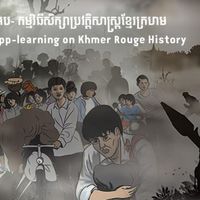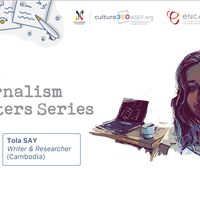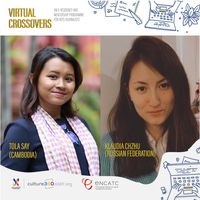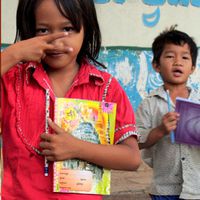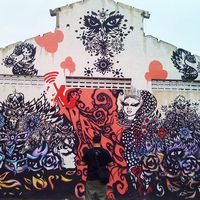Making Arts Accessible in Rural Areas of Cambodia

This article is the result of the research conducted by Tola SAY during the e-residency Virtual Crossovers, organised in April 2021 by ASEF and ENCATC, the European network for cultural management and policy. Tola worked closely with her mentors Carla Figueira and Musa Igrek to understand how arts can become more accessible to local communities in Cambodia. Here is what she discovered.
Chapei Master Kong Nai
Growing up in Pursat, in the western part of Cambodia, in the early 2000s, my daily life was accompanied by the songs of influential singers from the 1960s such as Sinn Sisamouth, Ros Sereysothea, and Pen Ran. These songs continue having deep power and meaning for Cambodians like myself in the present – especially because so many farmers, scholars, and artists, including the ones mentioned, were killed during the Democratic Kampuchea regime (1975-1979) known globally as the Khmer Rouge.
The genocide had a very negative and long-lasting impact in the ecology of culture in Cambodia. In fact, the country has only one post-secondary arts school, the Royal University of Fine Arts; one National Museum which is dedicated entirely to antiques of the Angkor era; no permanent art space to exhibit contemporary artwork; and, since Preah Suramarit National Theatre was demolished in 2008, no proper theatre. And, while the arts infrastructure in the capital city of Phnom Penh is less than ideal, there are fewer opportunities still in the rural parts of Cambodia which lack the art schools and private galleries of cities like Battambang and Siem Reap, as well as access to artistic experiences and training. Many of the Cambodian artists and cultural practitioners I meet tell me that they only learned about “arts” when they came to study in the city.
But it is important to enable all Cambodians to develop their appreciation for the arts through access to arts education and programming because arts is an effective tool to create cultural awareness, a sense of identity, as well as to boost people’s creativity and innovation. Cambodian youth, and numerous local and international entities are beginning to work to fill this gap in the cultural sector. Therefore, this article explores contemporary approaches to arts education and programming in Cambodia by interviewing different stakeholders, including Cambodian and international governments, arts organizations, and foreign donors whose support and work are helping to make the arts accessible throughout Cambodia.
Sbek Thom
Technological developments have long been very important in providing access to particular art forms in rural areas in Cambodia. In the early 2000s, Lakhoan Vithyu radio dramas often adapted from Khmer novels were broadcasted widely; as a child, I remember that my family and I would always rush to finish our lunch to ensure that we did not miss any episode of the radio dramas. In that period, Lakhon Bassac traditional operas were performed in different parts of the country during the Khmer New Year and other national celebrations, and I remember clearly that, once or twice a year, most of the villagers and my family would carry handcrafted mats to a pagoda from 4 in the afternoon to find good spots to sit and enjoy Lakhoan Bassac performance till the middle of the night. After we watched it, we could always play around by mimicking words from comedians (Tlok) and giants (Yeak) roles.
And yet, with the more recent rise in the use of social media throughout the country, these forms of performing arts and radio dramas seem to be disappearing. Moreover, the use of mass media to make available cultural content to populations may also have unexpected results; for, while there is some Khmer arts and culture-based content being broadcasted and discussed in the mainstream media, most people, including those who live in rural areas, tend to appreciate and enjoy Thai, Chinese, Indian or Korean dramas which have more distribution slots than national arts-centered programmes.
An additional challenge is that Cambodian youth seem to be more fascinated with Cambodian pop and rap music, as well as with foreign culture such as K-Pop, than they are interested in traditional Khmer culture. Their preference is clearly seen through their discussions and activities on social media platforms, mainly Facebook and TikTok. For example, people can observe the great number of youth participation in music concerts hosted across Cambodia, mainly sponsored by beverage or beer companies, whereas only a small number of youths would enjoy Lakhon Khol Cambodian masked dance theatre, Sbek Thom Khmer shadow theatre and other forms of classical, traditional and contemporary forms of arts.
Wood block printing workshop
Getting the younger generation to have more access and be more knowledgeable and appreciative of Cambodian traditional culture is a concern for many working in the arts, both at the government level and in the cultural sector. To enable people, especially in remote areas, to access various Khmer traditional and classical arts, the Cambodian Ministry of Culture and Fine Arts (MoCFA) has been trying to get public attention and participation through various approaches. Dr Siyonn Sophearith, Director-General of Techniques for Cultural Affairs, notes:
“In the present day, there are many digital tools to share information, yet it cannot help ensure that our art knowledge and information reach out to people in remote areas.” Siyonn continues: “We have been collaborating with TVK and other TV channels, as well as some radio stations to host traditional arts and cultural programs.”
Touching on the influx of foreign culture influence on Cambodian youths via technology, Siyonn acknowledged he too has noticed this matter and highlighted that it is important to get youths to participate and enable them to experience Khmer arts and culture events. So far, he said the MoCFA has been using different techniques to encourage youths including promoting the ‘youth for national culture’ theme in an annual national cultural day and making arts more accessible by hosting events online. However, he added that it is not easy for one to have a passion for arts and to feel that they should take part in promoting and preserving their own culture if these ideas have not been nurtured from an early age.
Cambodian Royal Ballet
The importance of arts education in Cambodia is recognized by the government, and in recent years some partnerships have been developed to reinforce it. Siyonn explains the official rationale and plans:
“Kids cannot appreciate and love things unless they are exposed to arts and understand it as they are young. We thought about it. Based on the objective of the cultural policy ‘education for culture and culture for education’, however, it is a national affair that we cannot achieve alone. Therefore, we collaborated with Cambodian Living Arts (CLA), UNESCO and the Ministry of Education, Youth, and Sports (MoEYS) to sign a Memorandum of Understanding (MoU) to do a pilot project (2017-2022) on arts education.” And voices from those implementing these projects, tell us that this is working.
After the MoU was signed, pedagogical coordinator and Phnom Penh based New Generation School art teacher Kong Vollak expressed that 7th graders were very excited and actively engaged in the drawing and handcrafting classes. He said it was a very successful project and it resulted in the expansion of the programme which included music and dance subjects, as well as an in-progress intangible cultural heritage studies programme. Vollak emphasized these positive results: “Arts education helps students think creatively and be innovative. When we look at it critically, it is interrelated with other science subjects. After four years of implementing this programme, I can see remarkable results through the outcome of students’ learning. At once, my students told me that they would not have made an attractive and useful robot if they had not been in arts education.” Nevertheless, he added that it was very challenging for him as a teacher, as well as for the students in the beginning, because, although his students are passionate about drawing, they could not draw as they did not learn the basics while in primary school. It is therefore pertinent to ensure that arts education is embedded at all levels of education in Cambodia. This will pave the way for a new generation that is more confident in itself and in its heritage.
The support of foreign organisations aiding Cambodia in developing arts education, as well as the cultural sector, is very important. Discussing what kind of arts education should be developed in primary school throughout the country, Vollak mentioned the Japan Team of Young Human Power (JHP), a Japan-based organisation whose activities in Cambodia focus on construction of school facilities and provision of music/art education, has partnered with MoEYS, Japan International Cooperation Agency (JICA) and Cambodia independent artists to produce contents of art book drafts for students at the primary level. He said a minister of MoEYS has signed on arts book drafts and the organisation has been working on pilot projects in Kandal and Takeo provinces. Although the project is mainly done by the foreign organisation, Vollak complimented the books’ content and design, saying that they are well produced and attractive to young students.
Foreign support was also key to the production of the NomadiX Art Tour, which aimed to celebrate and make arts and cultural events accessible in rural communities. Marina Pok, Creative Director of Annica Foundation and co-founder of NomadiX Art Tour, explained that the idea to create the art tour with different visual artists outside the capital came from her observation that students and people in those remote areas rarely had the opportunity to experience arts and culture events for themselves because most of these programmes are organised in the city. Pok explains the process: “We invited students from different schools and people in the villages in Kampot and Siem Reap provinces to participate in interactive workshops, panel discussions and collaborative exhibitions which are the main activities of our tours. We also had performances from local artists because we thought that that is how people can start to understand arts by just looking at their own community art forms.” Pok noted that she and the artists on the tour have received positive feedback from teachers and students who say that the arts tour programme brought much excitement and inspiration to students as the programmes delved into the Cambodian contemporary arts to create stories and artworks that reflect their personal experiences and reality. However, Pok observed that her project, which was a part of the International Women’s Day 2020 celebration, would not have been possible without the monetary support from different actors and entities, especially the United Nations and the Swedish Embassy.
Cambodian Royal Ballet
Magnus Saemundsson, first secretary from the Embassy of Sweden, explained that the Swedish government has been supporting many arts and culture events in Cambodia, as part of their policy of foreign affairs addressing gender issues. He noted: “The Swedish embassy in Cambodia has projects valued between USD150,000 and USD200,000 for arts and culture activities annually. Arts and culture are linked to social and economic development. Arts helps people open their minds and think critically and innovatively. Therefore, it is a very important part of a foreign government, like Sweden, to support and encourage people’s participation in this area.” Saemundsson recalled that the Swedish embassy in Cambodia has been sponsoring International Women’s Day since 2019 when it worked with music company production Baramey to do music concerts and produce music videos with gender issues and human rights contents. He further stressed in relation to access to arts in rural communities that:
“We think that it is crucial to support visual artists to celebrate arts in remote communities regardless of its scale, to work on a long-term basis and around the country because there are not many arts and culture activities or events for rural communities to experience. The goal of this support is to engage people in arts and inspire them to think critically.”
To implement arts education and to promote cultural and arts programmes, it seems Cambodia still needs a large amount of support from international organisations and foreign donors. And yet, while varied stakeholders have been actively supporting arts education in the country, their scope of support changes according to the direction of their foreign policies and organisations’ vision. Thus, a long-term strategy for the arts sector in Cambodia should strive to carefully balance local and international funding models to ensure that the sector is ultimately able to sustain itself.
To address the ‘unpredictable’ support of foreign entities, the Cambodian government should allocate a larger amount of its national budget to the cultural and creative sectors to improve the current situation of Cambodian arts, as they have done with the education (and national defense) sector. Moreover, to get the public’s attention and ignite people’s curiosity about the arts in all parts of the country, various mainstream and digital platforms should be fostered by the Cambodian government.
As the country evolves, the Cambodian arts scene has been developing too. However, if we look at the current state of Cambodia’s arts infrastructures, there is no proper theatre hall, including in the capital, no spaces for artists to rehearse or showcase their contemporary performing arts; no schools for students to study filmmaking/cinema; and no permanent space/museum for artists to exhibit their contemporary artworks and for students to experience them, except for a private art space owned by a French national called “Romchek 5 Art Space” in Battambang province. The latter can be an example on how alternative spaces can be created by non-state actors, but it is important and urgent for the government to take responsibility and address these issues by creating fully equipped physical spaces for people to have artistic and cultural experiences and study/train.
The Cambodian government and the cultural and creative sectors independently and collaboratively can make a difference and enable arts, heritage and creativity to be experience in different ways. People get different benefits from seeing artworks physically, watching performing arts on the screen and attending living arts performance. They also benefit from directly engaging in creating and producing those cultural experiences themselves and with their communities, while developing links with those further afield, either in other regions of the country or abroad. I believe that more consistent arts access and participation for all can energise large numbers of youth who are based in the remote areas to think creatively and innovatively, to have national and international arts and cultural awareness, and to develop a sense of belonging by taking part in preserving and developing their national arts and culture.

SAY Tola is a passionate writer and researcher of arts. She worked for Khmer Times from 2017 to 2019 during which she wrote about the arts scene in Cambodia. She was also on the core organising team for the ‘Khmer Literature Festival’ and ‘Battambang Literature Festival’ for three years. Her keen interest in arts and culture research saw her playing a significant role in ‘Her Sounds’ project as a coordinator in 2019. That year, she also became a resident researcher with Heritage Hub Residency at the REPfest New Traditional Music Festival. In 2020, Tola worked as a research assistant on an international project called “Documenting the instrument and instrument-making of Angkuoch, Cambodian Mouth Harp” as part of the Endangered Material Knowledge Programme. All these projects gave her the opportunity to travel throughout Cambodia to witness diverse arts and cultural practices in various communities.
Virtual Crossovers is a one-month virtual residency and mentorship programme organised by culture360.ASEF.org in partnership with ENCATC, the European network for cultural management and policy.
Similar content
posted on
27 Jul 2017
By Tola SAY
02 Mar 2023
posted on
31 Mar 2021
By Jérémy Segay
03 Oct 2005
16 Jan 2017







